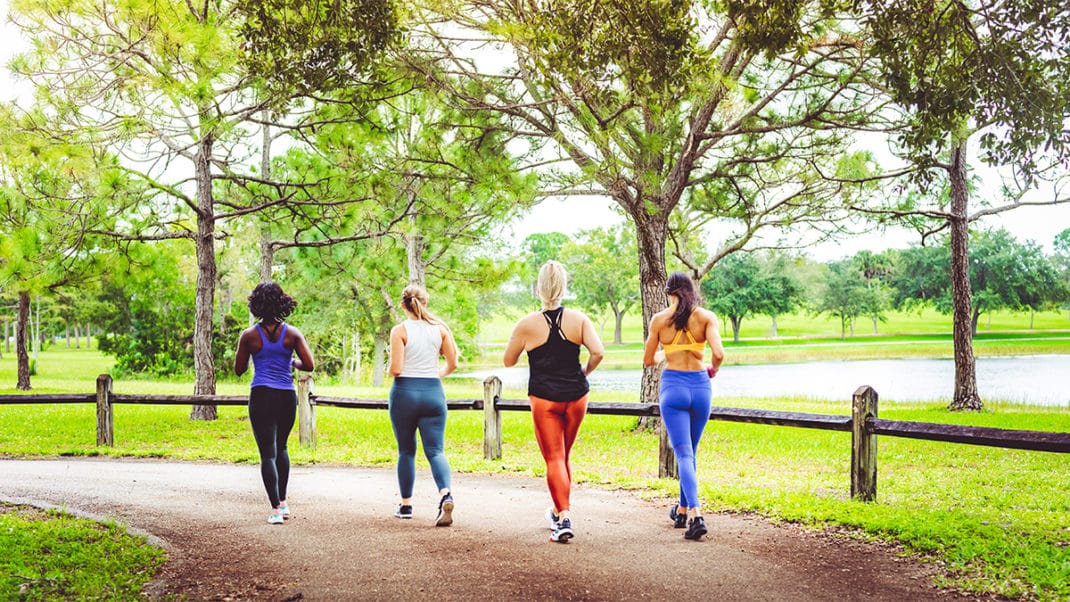Shaping a Healthier Future for America’s Children
10 ways to work with schools to improve kids' fitness.
As a fitness professional, you ignite a passion for physical activity in each person with whom you work. You empower clients to achieve their fitness goals, and you inspire them to develop a lifelong commitment to maintaining their health and well-being. In this sense, you are accomplishing your mission.
But there is an entire population in dire need of your expertise, and the people in this group rarely walk through the doors of a health club. According to a 2004 research review, 9 million American children are at increased risk of social marginalization as well as type 2 diabetes, cardiovascular disease and myriad other morbidities due to being overweight (Lobstein, Baur & Uauy 2004). The study also notes that despite unrelenting publicity and substantial public health efforts to combat childhood obesity, 0.5% of American kids are added to these sad statistics every year. Contributing to the problem is the fact that while most children spend at least 180 days in school each year, only 8% of elementary schools, 6.4% of middle schools and 5.8% of high schools provide daily physical education (Institute of Medicine 2004).
Rigorous academic standards and budget constraints limit the amount of time schools can allocate to organized physical activity. However, fitness professionals are well equipped to bring motivating, effective and safe physical activities to America’s schools while working within current limitations. Now is the time to move America’s children to a healthier future. Here are 10 ideas to get you started.
Most kids hate physical education (PE) classes. They change their clothes, wait in line while the teacher takes attendance, try to participate, get ignored or ridiculed by the more athletic students, and then tune out. For many kids, a 50-minute PE class does not even begin to provide the 30 minutes of sustained daily physical activity recommended by the Institute of Medicine (2004).
Paul Rosengard is executive director of Sports, Play & Active Recreation for Kids (SPARK), a groundbreaking program that makes exercise fun while engaging students in moderately vigorous physical activity. Rosengard urges fitness professionals to improve school PE programs by volunteering, either regularly or just occasionally. He suggests a variety of ways to provide this critical service to kids and PE instructors:
- Teach your area of expertise while the PE teacher observes and learns.
- Assist with a class by working with a group of students who need more individual attention than the structured PE class can provide.
- Attend SPARK PE workshops to learn the program, and then assist teachers with implementation.
Rosengard adds, “We want to see PE look a lot more like a health club and a lot less like it does now. At the IDEA conference, for example [we saw that] everyone is teaching lifetime fitness pursuits (e.g., yoga, Pilates, step, [exercise with] the Bosu® Balance Trainer, etc.), and this is what we should be doing much more of in schools, especially at the middle-school and high-school levels. I believe we’re very much missing the boat on having the fitness professional come into schools and instruct these classes . . . so the teachers can also learn how to teach them. . . . Health clubs will be looking to these kids to be their future members.”
Federal legislation, such as the No Child Left Behind Act, leaves teachers strapped for time and unable to devote significant portions of the day to nonacademic activities. Nonetheless, fitness professionals can work with teachers to integrate physical activity and nutrition information into existing curricula. For example, at an elementary school in Redmond, Oregon, Judy Shasek, a fitness professional and former teacher, has partnered with RedOctane, a manufacturer of dance mats, to pilot the Dance Develops Readers program. Shasek trains 40 third and fourth graders to teach their peers a fun and moderately vigorous routine on the dance mats. At intervals throughout the school day, these “coaches” lead their peers (approximately 120 of them!) in exercise directly outside the classroom, in sight of the teacher. Shasek reports that the kids’ confidence and self- esteem have increased and their concentration and reading ability have improved.
Another option would be to implement the VERB™ Play Without Borders kit from the Centers for Disease Control and Prevention (CDC) (see “Resources” on page 47). In this model, middle-school children play games from around the world—complementing lessons on world cultures. Alternatively, when a teacher is presenting a unit on plant biology, you could provide an introduction to the Food Guide Pyramid and offer a smorgasbord of nutrient-dense fruits and vegetables for the kids to sample.
Every morning before the sun rises, 25 Connecticut youngsters wake up eager to spend an hour playing whatever games they want at Parker Memorial Elementary School. Jaci VanHeest, an associate professor of kinesiology at the University of Connecticut (UConn) Neag School of Education, has developed Paw PALS (named for UConn’s husky mascot and for Physical Activity as a Lifetime Skill, the program’s main objective), a before-school physical activity program for third and fourth graders. After a warm-up and a brief educational session on topics such as heart rate monitoring and using a pedometer, the kids—mostly overweight and longtime PE haters—use the next 45 minutes just to play. And they love it! According to VanHeest, “Unless the kids are so sick they can barely walk, they’re there.”
In Fairfax, Virginia, middle-school students look forward to the end of the school day when they can get fit using the latest equipment, including agility ladders, mini hurdles, medicine balls, The Body Bar™ and Bosu balls. Denise Moser, a health and PE teacher at Lanier Middle School and a certified personal trainer, has developed Bootcamp, a weekly after-school program, to teach kids functional fitness. The voluntary, not-for-credit class has attracted more than 50 kids—including some who are overweight, sedentary or disabled as well as those who are naturally athletic. “The best part of the class,” Moser says, “is watching the kids improve and have fun.” Moser points out that exercises can be easily modified to address the needs of children with disabilities.
The success of both VanHeest’s Paw PALS and Moser’s Bootcamp is attributed to the fun factor. You are in an ideal position to provide an exciting program that helps kids enjoy being healthy, whether through a unique program or a tag-on to an existing program, such as the CDC’s KidsWalk-to-School initiative (see “Resources” on page 47).
Student council, National Honor Society and math club aren’t the only extracurricular activities worthy of middle-school and high-school students’ time. A lot of kids want to learn more about nutrition and exercise and to share that information with their fellow students. Peer influence, a potent motivator in the preteen and teen years, is much more effective than advice from an adult. So start a students’ nutrition and physical activity group by working with a school nurse or an interested teacher.
Students could develop theme weeks, incorporating programs like 5 A Day (www.5aday.com) or 10,000 Steps (www.shapeup.org/ 10000steps.html); hang posters and banners throughout the school to disseminate nutrition and fitness information; sell healthy foods at athletic events; develop a newsletter featuring articles on good nutrition, physical activity and healthy recipes; or organize games. Older students can work with and mentor elementary-school students. This type of program encourages adolescents to develop creative ways to reach their friends and classmates while you help turn their ideas into reality.
While you may be able to spend a few hours a week working with students as a volunteer, teachers have months to encourage kids to value healthy behaviors. Teachers can not only model healthier behaviors but also include nutrition and physical activities in their daily lessons. But first you need to sell the teachers on the idea that the results are worth the time and effort. Helping school staff develop healthier lifestyle behaviors can shape a better future for their students. What’s more, by developing collaborative relationships with teachers, you generate support and gain permission to work directly with students.
Secure teacher and administrator “buy-in” by leading a weekly fitness class for the school staff, presenting at school meetings, organizing an informational campaign (using flyers or e-mails) or asking teachers what you can do to advance healthy physical activity in their school.
The Institute of Medicine (2004) encourages parents to promote healthful eating behaviors and regular physical activity in their children. But how do parents recognize and teach healthy nutrition choices or learn how to make exercise fun? You can inform them in several ways:
- Publish a parents’ column in the school newsletter and include information on nutrition and fitness fundamentals.
- With the school principal, coauthor a letter that instructs parents on things their kids can do to stay healthy over summer vacation.
- Offer to contribute information to a parent listserver.
- Volunteer to write an article for the school webpage.
The key is to build a partnership with a local school so you can determine the most effective strategies for reaching students, staff and parents.
The influence of a youth athletics coach extends far beyond honing a skill, promoting fitness and making exercise fun. A coach can shape a child’s attitudes, values and self-esteem. A coach can ignite passion. You don’t have to be an exceptional athlete. You don’t even have to play a sport. Girls on the Run®, a national program that uses running to teach 9- to 11-year-old girls confidence and healthy behaviors, consists of a 12-week standardized curriculum that can be implemented in communities across the country (see “Resources” on page 47). Coaches are selected based on their passion and commitment to the kids, not on how fast the candidates run a mile.
Coaches with a background in fitness and the personal commitment to make a difference are in high demand, so get involved—through a school, a local youth sports league or a national program.
Health professionals, parents, teachers and community members in districts across the country provide a voice for health promo-tion in America’s schools as members of local school health advisory committees. These committees advise school administrators and school boards on various health-related topics, including overall health, physical activity, nutrition, tobacco-use prevention and sex education. Committee members make recommendations regarding the number of hours in the school day that should be devoted to health and PE and appropriate changes to improve the nutritional quality of foods offered on campus. As an active committee member, you would be well positioned to make change happen.
Although each state is different, committee members are typically appointed by the school board or district superintendent. The best way to learn about available positions, member requirements and time commitment is to contact school principals or district superintendents. Also ask what other opportunities exist for you to get involved and build students’ healthy minds and bodies.
Everyone knows that childhood obesity is a problem. But what are communities doing about it? Become the voice of change. Here’s how:
- Attend school board and Parent-Teacher Association meetings to advocate for more time and resources for PE and healthier food choices in district schools. Provide stakeholders (parents, teachers, health departments, school businesses, etc.) with the latest research and data to support your position.
- Join associations like Action for Healthy Kids™, a national initiative to improve nutrition and PE in schools. This initiative is supported by organizations such as the American Academy of Pediatrics, the National School Boards Association, the U.S. Department of Health and Human Services and the American Federation of Teachers.
- Sign up for the National Coalition for Promoting Physical Activity’s listserver (www.ncppa.org) to stay abreast of the latest state and federal policy initiatives. Write your state and federal legislators to support bills that improve school health education.
- Work with the owner of your facility, if applicable, to develop a kids’ fitness initiative in your community.
- Spread the word about kids’ fitness—in your classes, at the grocery store, on the bus and when chatting with friends.
Create a way to use your strengths to make being fit and healthy fun, rewarding and “cool.” Taking advantage of its unique resources, the Ringling Bros. and Barnum & Bailey® Circus brings fun and fitness to Chicago’s Cicero Roosevelt Elementary School with CircusFit, a program that uses performers, peacock feathers, balls, hoops and scarves. Lori Lowell, owner of two Gold’s Gyms in the Washington, DC, area, does her part by working with school guidance counselors to offer free 6-month gym memberships to high-school seniors. The students attend two fitness classes per week, write about their experiences and complete an interview at the end of the program. The senior with the best results (determined by consistency, willingness and his or her personal story) receives a $2,000 scholarship for college.
If we all innovate and do our part, we will shape the path for America’s children to move one step closer to a healthier future.
Do the Research.
- Gain a complete understanding of the problems of childhood obesity, physical inactivity and poor nutrition in your community.
- Learn what programs have been effective in working with schools to improve children’s nutrition and physical activity. Talk to the people who have made those programs successful.
- Conduct a needs assessment in your community. What is currently being offered? What is lacking? Which stakeholders (parents, teachers, professors, health departments, school boards, community businesses, etc.) might be interested in supporting and contributing to the development of a children’s fitness program or initiative?
Develop a Plan.
- Use the results of your research to develop a program idea that taps your talents, qualifications and passion. Don’t be afraid to apply your talents to help strengthen a high-quality and effective pre-existing program instead of developing something entirely new.
- Anticipate potential problems and setbacks and, if possible, solve them in advance. For example, schools may be hesitant to allow outside individuals to work directly with the students. However, teaming with nearby universities and professors may make getting your foot in the door much easier.
- Gain the commitment of other professionals, community members and stakeholders who have expressed interest in helping with the program’s implementation.
Write a Proposal.
- If you need funding for the program, complete the funding source’s required application (see “Funding Kids’ Fitness Programs” on page 46).
- Write a one-page proposal briefly highlighting research findings, an overview of the proposed program and your qualifications. Be prepared to provide more detailed information if asked.
Establish Contact With Principals, Teachers and Other Important Stakeholders.
- Send your proposal and a formal cover letter, including your contact information, to the person who has the authority to approve your program and is most likely to work with you to make it a reality.
Follow Up.
- Follow up with a phone call 1–2 weeks after submitting your proposal, to be certain that it has been received. Make yourself available to answer questions. School administrators are very busy—be persistent but not overbearing.
Get Moving.
- At this point, your idea has been accepted. Congratulations! Now it’s time to develop a final schedule, prepare, and present what you have to offer!
Evaluate the Program.
- Once the program is over, ask the children to evaluate how much they liked it. Also ask other stakeholders and players for their feedback and ideas for improvement. Revamp the program based on their suggestions and your own ideas and observations.
Do you have a great idea for a kids’ fitness program but not know how to fund it? Fortunately, numerous grant opportunities exist for initiatives committed to improving kids’ fitness and combating childhood obesity. Funding resources include the following:
Local Corporations, Cities and Community Members. Explore the resources in your community. Many organizations are committed to giving at the grass-roots level. For example, Wal-Mart funded over $85 million in community grants to schools, nonprofit organizations, government agencies, religious organizations, and civil and veterans’ groups in 2003.
NikeGO (www.nikego.com). Schools and nonprofit organizations are eligible for NikeGO grants, cash awards for programs designed to support kids’ fitness. After-school and summer programs are high on NikeGO’s priority list.
PE4Life™ (www.pe4life.com). Through the U.S. Department of Education’s Physical Education for Progress (PEP) grants, PE4Life awarded $69 million to more than 230 schools and communities in 2004. The PEP program “is designed to assist local educational agencies and nonprofit, community-based organizations to initiate, expand or improve physical education programs, including after-school programs, for students in one or more grades from kindergarten through 12th grade in order to help students make progress toward meeting state standards for physical education.”
Shaping America’s Youth (SAY) (www .shapingamericasyouth.com). SAY is an organization committed to providing a wealth of resources to schools and communities interested in improving children’s nutrition and physical activity. Over 40 opportunities are posted on the SAY website, and information includes funding sources, contact information, award amount, eligibility criteria and application deadlines.
Myriad resources exist to inform, motivate and guide fitness professionals committed to improving kids’ fitness.
Action for Healthy Kids (www.actionforhealthykids.org). Learn how to get involved with your state team to improve nutrition and physical activity in your local schools. This website provides a wealth of information on the importance of schools in combating childhood obesity.
The Centers for Disease Control and Prevention’s VERB (www.cdc.gov/youthcampaign/index.htm). Get a list of websites that offer practical ways to get kids active at home, in school and in the community. The main VERB website (www.cdc.gov/youthcampaign/materials/ tweens/) provides information about the initiative and access to program materials.
Fitness for Youth (www.fitnessforyouth.umich.edu). Visit this University of Michigan webpage for comprehensive information on successful youth fitness programs, tips on effectively running a program, links to resources and the latest research.
Girls on the Run (www.girlsontherun.org). Learn more about how to coach 9- to 11-year-old girls as they develop self-respect and healthy lifestyles through running.
KidsWalk-to-School (www.walktoschool-usa.org). Get a step-by-step guide to starting a neighborhood walking program.
National Coalition for Promoting Physical Activity (www.ncppa.org). Stay on top of the latest legislation and news concerning nutrition, physical activity and obesity.
North American Association for the Study of Obesity (www.naaso.org/news/20041115a.asp). Check this link for a summary of successful school-based obesity prevention programs.
SPARK (www.sparkpe.org). Find out how to get involved with the organization that is changing the face of school PE.
References
Datar, A., & Sturm, R. 2004. Physical education in elementary school and body mass index: Evidence from the early childhood longitudinal study. American Journal of Public Health, 94 (9), 1501–6.
Institute of Medicine. 2004. Schools can play a role in preventing childhood obesity; and Communities can play a role in preventing childhood obesity. Fact sheets drawn from Preventing Childhood Obesity: Health in the Balance. www.iom.edu; retrieved December 1, 2004.
Lobstein, T., Baur, L., & Uauy, R. 2004. Obesity in children and young people: A crisis in public health. Obesity Reviews, 5 (1, Suppl.), 4–85.
Ringling Bros. and Barnum & Bailey. 2004. Kids get fit with CircusFit. PR Newswire, November 8.
Natalie Digate Muth, MD, MPH, RD
"Natalie Digate Muth, MD, MPH, RDN, FAAP, is a board-certified pediatrician and obesity medicine physician, registered dietitian and health coach. She practices general pediatrics with a focus on healthy family routines, nutrition, physical activity and behavior change in North County, San Diego. She also serves as the senior advisor for healthcare solutions at the American Council on Exercise. Natalie is the author of five books and is committed to helping every child and family thrive. She is a strong advocate for systems and communities that support prevention and wellness across the lifespan, beginning at 9 months of age."






